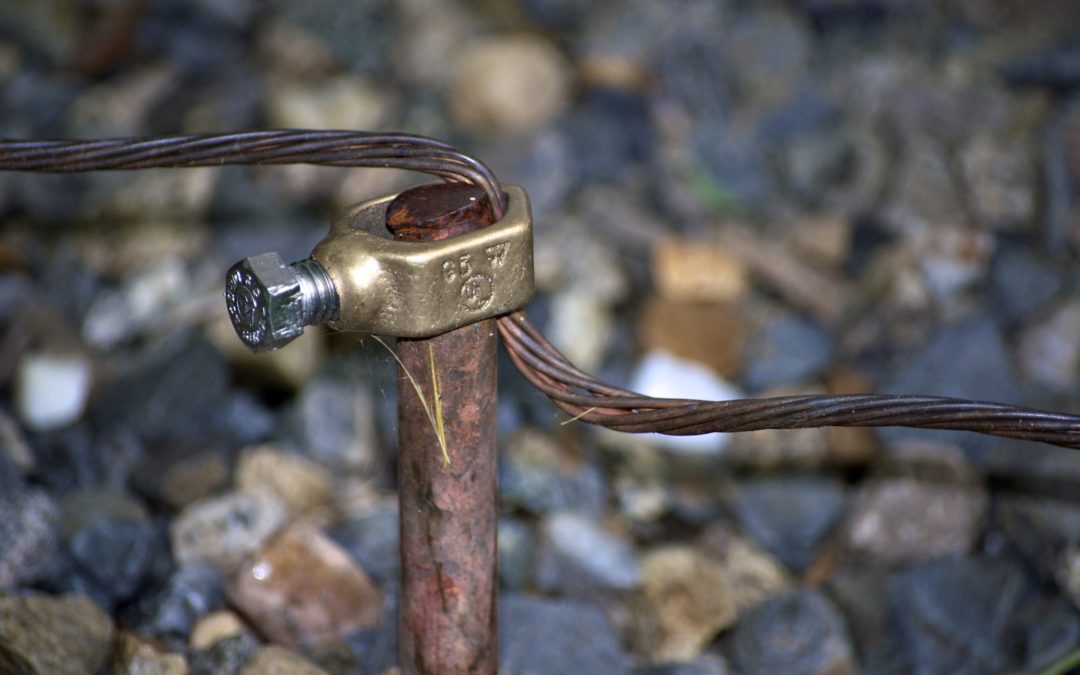A fundamental component of safety and protection for your business and/or home’s electrical system is proper grounding. For this reason, one or more ground rods are required on your property by the National Electrical Code (NEC) and local building codes. Ground rods are simple and inexpensive but are crucial to protecting your electric equipment and appliances, and therefore, must not be neglected.
What is a ground rod?
A ground rod is usually located very close to your main electrical service panel and is often made of copper or copper coated steel. They’re approximately one-half-inch in diameter and 8 to 10 feet in length. It must be electrically tied to your main service panel to provide an approved ground connection.
If a single ground has a resistance of 25 ohms or less, building codes allow it to be used as the only grounding device. If the resistance of a ground rod is greater than 25 ohms, at least one additional ground rod is required.

Ground rods are simple and inexpensive but are crucial to protecting your electric equipment and appliances.
Inspecting your ground rod
Ground rods and their connections to your business or home’s electrical system may be damaged over time and must be properly maintained. Causes of damage include corrosion, freeze/thaw cycles, landscaping equipment or careless installation of grounds for other equipment, such as cable TV, security systems or generators.
A visual check of grounding can be done by inspecting the wire that connects the electrical panel near the meter to the ground rod. Typically, this is a copper wire about one-fourth-inch in diameter and can be seen going down into the soil. Below the surface, the wire is connected to one or more ground rods. The tops of the ground rods are typically below the surface and may not be easy to inspect. However, sometimes ground rods extend a few inches above the surface, making it easy to inspect the connection.
In some cases, problems with ground rods are easy to see. Rods that are not fully installed may extend a foot or more above the surface of the soil. This reduces the effectiveness of the ground. Ground rods that are bent over, have disconnected wires or are severely corroded must be replaced. Ground rods that are installed in rocky or dry soil should be checked to make sure they still have a low resistance. If soil conditions change due to drainage or other factors that affect soil moisture, a ground rod that was acceptable at the time of installation may no longer meet approved requirements.
Unfortunately, we have no control over how well your electrical panel is grounded. If you do not provide proper grounding in accordance with the NEC, there is no way to mitigate electrical damage that may occur beyond your electrical panel. If you have concerns about your business or home grounding, contact a licensed electrical contractor.
Protection against power surges
Among the various situations that may occur on your electrical system, the most common are high voltage surges, and damage or loss of one of the service conductors.
- High voltage surges are often caused by lightning strikes on or near power lines. In addition, voltage spikes can occur when large appliances or heavy machinery at nearby locations are switched on or off. Proper grounding provides stability to your home’s electrical system and reduces the impact of these surges.
- Should a tree branch fall, or a car hit a pole, the service wire from the utility system to your home may be disrupted. Proper grounding of your home and business is important to eliminate or minimize the possible damage. With insufficient grounding, varying voltages in the home may cause damage to motorized appliances due to under voltage or damage to electronics as a result of overvoltage.
Another critical issue relative to sensitive electronic equipment is the proper installation and operation of surge protective devices (SPD). The best surge protection equipment is much less effective without a properly installed and maintained grounding system. The SPD works by shunting damaging electrical surges away from your sensitive electronics to ground, and they need the best possible ground to work properly.
Therefore, it is necessary you have and need to maintain a NEC code-approved ground system as part of your electrical system.
This blog’s creation originated from Peninsula Light Co.’s grounding blog which can be found here.
